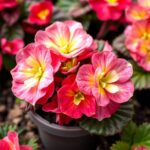Is Lobelia a Perennial or Annual? Discover the Truth About This Popular Plant

Lobelia is a popular choice among gardeners for its vibrant colors and appealing foliage. However, a common question arises: is lobelia a perennial or an annual plant? Understanding the life cycle of lobelia is crucial for anyone looking to incorporate it into their garden or landscape. While some species thrive year after year, others may only last a single growing season. In this article, we will delve into the characteristics of lobelia, explore its various types, and provide clarity on its classification. Join us as we uncover the truth about this beloved garden staple.
Is Lobelia a Perennial or Annual?
Lobelia is generally classified as a perennial plant, but its lifespan can vary based on the specific species and growing conditions. Many types of lobelia, particularly Lobelia erinus, are considered annuals in colder climates due to their inability to survive frost, while others, like Lobelia cardinalis, thrive as robust perennials in USDA zones 3-9. The environment, including temperature, soil conditions, and care provided, plays a crucial role in determining whether lobelia behaves as an annual or a perennial in a particular region.
Different Species of Lobelia
There are over 400 species of lobelia, each with varying characteristics regarding growth habits. Some species, like Lobelia erinus, are often used in hanging baskets and as annuals due to their delicate appearance and ability to tolerate light frosts. Other species, such as Lobelia cardinalis, are known for their vibrant red flowers and are typically grown as perennials, favored for landscaping in perennial gardens.
Climate Influence on Lifespan
The climate in which lobelia is grown significantly impacts whether it behaves as an annual or perennial. In warmer climates (USDA zones 8-10), lobelia can thrive as a perennial, while in cooler climates (below USDA zone 7), it often acts as an annual. Seasonal temperature fluctuations, frost dates, and overall weather patterns can lead to different growth outcomes for the plant.
Cultivation and Care Tips
Proper cultivation practices can also influence whether lobelia survives year after year. Regular watering, appropriate soil treatment, and fertilization can enhance the plant's chances of surviving and flourishing as a perennial. Moreover, if gardeners provide adequate winter protection, such as mulch, they may increase the likelihood of their lobelia returning each spring.
See also:
Popular Uses of Lobelia
Lobelia is popular in landscaping and gardening due to its striking flowers and variety of colors. It's often utilized in containers, borders, and hanging baskets, adding visual interest and vibrant colors to outdoor spaces. Gardeners may choose different species based on their desired outcome, whether for annual displays or perennial garden beds.
Resilience and Pest Management
Lobelia is generally resilient, but it can attract pests such as aphids and slugs, which may affect its growth as a perennial. Implementing proper pest management strategies, like using insecticidal soap or encouraging beneficial insects, can help maintain healthy plants, ensuring they thrive whether they are treated as annuals or perennials.
| Species | Lifespan | Color |
|---|---|---|
| Lobelia erinus | Annual | Blue, Purple |
| Lobelia cardinalis | Perennial | Red |
| Lobelia siphilitica | Perennial | Blue |
| Lobelia inflata | Perennial | Blue |
Understanding the Lifespan of Lobelia: Annual vs. Perennial
Lobelia is often celebrated for its vibrant colors and versatile growth habits, but whether it is classified as an annual or perennial plant can lead to some confusion. Generally, Lobelia erinus, commonly known as trailing or spreading lobelia, is treated as an annual in colder climates due to its inability to survive frost. However, other species, such as Lobelia siphilitica, are recognized as perennials in regions with milder winters, where they can thrive year after year. Understanding these distinctions is crucial for gardeners who wish to incorporate Lobelia into their landscapes effectively.
What Factors Determine If Lobelia is Annual or Perennial?
The classification of Lobelia as either an annual or a perennial largely depends on several factors including climate, soil conditions, and care practices. In temperate regions, specific species can behave as perennials if they are protected from harsh winter conditions, while in colder areas, the same species may die off seasonally, leading gardeners to treat them as annuals. Soil drainage, moisture levels, and overall plant health also influence their resilience and longevity.
Common Species of Lobelia and Their Lifespan
There are several species of Lobelia, each with distinct lifespan characteristics. The most common include Lobelia erinus, usually seen in gardens as an annual, and Lobelia siphilitica, which is a true perennial found in North America. Also, Lobelia cardinalis is another perennial species, valued for its brilliant red blooms and ability to thrive in wetlands. Understanding these species helps gardeners select the appropriate types for their specific growing conditions.
See also:
How to Care for Annual vs. Perennial Lobelia
Caring for annual and perennial varieties of Lobelia requires different approaches. Annual lobelia thrives on regular watering and should be replanted each year, while perennials need less frequent attention once established. Ensuring proper drainage and avoiding overwatering is essential for both types, but perennial varieties also benefit from seasonal pruning and mulching to protect their roots through winter. Fertilization practices can vary as well, with perennials typically needing less frequent feeds compared to their annual counterparts.
Growth Habits of Lobelia: Trailing or Upright?
The growth habits of Lobelia also vary significantly and contribute to its appeal in landscaping. Species like Lobelia erinus are known for their trailing habit, making them ideal for hanging baskets and containers. In contrast, species such as Lobelia siphilitica have a more upright growth structure, providing vertical interest in garden beds. Understanding these habits aids gardeners in designing lush, colorful landscapes that utilize the unique properties of each Lobelia species.
Common Pests and Diseases Affecting Lobelia
While Lobelia is generally hardy, it is susceptible to common pests such as aphids and powdery mildew, especially when grown as an annual in conditions that aren't optimal. Perennial varieties may also face threats from slugs and snails, particularly if they naturally grow in moist environments. Monitoring the health of Lobelia plants and implementing integrated pest management strategies can help ensure their vibrancy and longevity, regardless of whether they are annual or perennial.
Questions from Our Readers
Is Lobelia a perennial or annual plant?
Lobelia can be both a perennial and an annual plant, depending on the specific species and the climate it is grown in. Some Lobelia varieties, like Lobelia erinus, are treated as annuals in colder climates, while others, particularly those that can withstand milder conditions, may be considered perennials.
How do I care for perennial Lobelia?
To care for perennial Lobelia, ensure that they are planted in well-drained soil and receive adequate sunlight, preferably partial shade. Regular watering is essential, but avoid waterlogging, as it can lead to root rot. Pruning them back in late fall can encourage healthier growth in the following spring.
See also:
Can I grow Lobelia from seeds?
Yes, you can grow Lobelia from seeds, and it is a popular method for starting both annual and perennial varieties. Sow the seeds indoors about 6 to 10 weeks before the last frost date, and keep them moist and in indirect light until they germinate.
What are the most common species of Lobelia?
Some of the most common species of Lobelia include Lobelia erinus, often known as trailing Lobelia, and Lobelia cardinalis, which is famous for its bright red flowers. Both species vary in terms of their hardiness and growth habits, making them suitable for different garden designs.

If you want to read more articles like Is Lobelia a Perennial or Annual? Discover the Truth About This Popular Plant, we recommend you check out our Plants category.
Leave a Reply
Related Articles